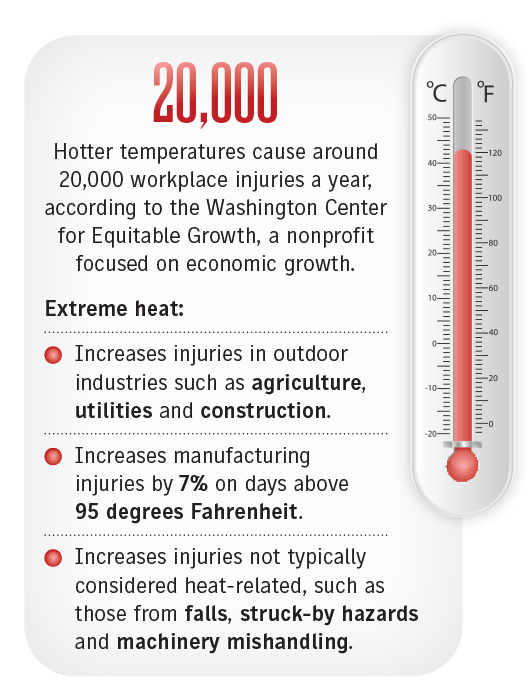Heat-related claims rise with climate change
Reprints
Rising temperatures are causing problems for workers in industries such as construction, warehousing and transportation, and heat-related workers compensation claims are increasing as a result, experts say.
As more claims are submitted, claims professionals are stepping up investigations to determine whether they are compensable.
Safety advocates, meanwhile, are urging the U.S. Occupational Safety and Health Administration to finalize a workplace safety standard that addresses the potential for heat-related injuries (see related story below).
Heat-related workplace risks are expected to increase, as insurers “across the country have identified climate change as an emerging concern,” said Patrick Coate, an economist with the Boca Raton, Florida-based National Council on Compensation Insurance, which is researching the connection between weather severity and increased worker injuries.
Insurers manage heat-related workers comp claims much like other injury claims, with investigations of causation and early treatment.
“When people are fatigued (from heat), they tend to not think correctly, they tend not to act correctly, and that results in injuries,” said Dennis Tierney, Norwalk, Connecticut-based national director of workers compensation claims for Marsh LLC.
Older workers or those with comorbidities may tire quicker or have a stronger heat reaction, Mr. Tierney said.
“Obviously, when these claims come in, we’re investigating them. We’re making sure they’re compensable,” he said.
Claims investigations include reviewing medications a worker is taking that could exacerbate heat issues, experts say.
 Insurers must also determine whether activities prior to an injury, such as excessive alcohol consumption, could have made a worker more susceptible to heat injuries, said Joe Paduda, Plainfield, New Hampshire-based principal with Health Strategy Associates, a workers comp consultant.
Insurers must also determine whether activities prior to an injury, such as excessive alcohol consumption, could have made a worker more susceptible to heat injuries, said Joe Paduda, Plainfield, New Hampshire-based principal with Health Strategy Associates, a workers comp consultant.
If a contributing factor did precipitate an injury, though, “the reality is this happened at work,” Mr. Paduda said.
“If they die of heat or they die during a heat event” it’s likely it will be a considered a work injury, he said.
More frequent heat waves are raising concerns about heat-related illnesses for a wide variety of employers across the U.S.
“The severity of just about every (heat) claim seems to be going up,” said Kevin O’Sadnick, St. Louis-based senior risk control manager for Safety National Casualty Corp.
Southern states tend to grapple more frequently with workplace heat illnesses and injuries as temperatures in that region increase. But experts say heat can affect employees anywhere — even indoors, such as in manufacturing facilities that lack proper climate control.
Climate change is also leading to more heat-related injuries in northern states, Mr. Tierney said.
Heat illnesses can include heat stroke, heat exhaustion, heat syncope — or dizziness and fainting — heat cramps, heat rash and rhabdomyolysis, which is a breaking down of muscle tissue. Heat stroke is the most serious and has the most potential to be fatal, according to the U.S. Centers for Disease Control and Prevention.
Instances of workplace fatalities caused by heat include an August 2023 case in which a UPS driver died from heat stroke in Texas, and another UPS driver died from what was believed to be heat stroke in June 2022 in California.
There were 36 confirmed work-related deaths due to environmental heat exposure in 2021, the most recent year for which statistics are available, according to the U.S. Bureau of Labor Statistics.
Exposure to heat can have long-term effects.
It can cause workers to develop illnesses such as acute kidney disease and chronic kidney disease that could ultimately complicate workers comp claims, said David Bonauto, a research director with the Washington State Department of Labor and Industries.
Heat can increase the absorption of chemicals in a person’s body, which could affect farmworkers who are exposed to pesticides, he said.
Most heat-related workers comp claims occur within the first two weeks of employment, suggesting new workers are at higher risk because they haven’t yet been acclimated to the work and environment, Mr. Bonauto said.
States lead way on heat safety standards
Absent a federal heat standard, employers often look to state safety rules and other best practices to reduce heat-related work risks.
As the U.S. Occupational Safety and Health Administration continues the rulemaking process for a federal health and safety standard addressing workplace heat, five states — California, Colorado, Minnesota, Oregon and Washington — have standards, which generally call for regular water and rest breaks for workers during certain weather conditions.
In February, the American Society of Safety Professionals published a voluntary consensus heat standard for the construction and demolition industries. It offers guidance on protecting workers, explains how to acclimate them to high temperatures and offers training for employees and supervisors.
“We’ve got to do things like provide water, shade, train employees to ask for help,” said Jeff Rush, workers compensation program manager for the California Joint Powers Insurance Authority in La Palma, California, a public risk pool. “Let’s get the employee hydrated; let’s do what we can to get them out of that heat environment.”
Some construction companies use wearable technology as a risk mitigation tool, noted Kevin O’Sadnick, St. Louis-based senior risk control manager for Safety National Casualty Corp. The devices can monitor body heat and activity to help ensure workers don’t become overheated.
Employers should involve workers in heat illness prevention efforts, said Marcy Goldstein-Gelb, co-executive director of the Somerville, Massachusetts-based National Council for Occupational Safety and Health. She suggested that employers have a health and safety committee that includes workers to identify heat-related hazards.